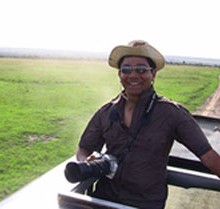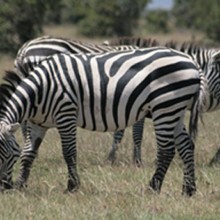
Mayank Lahiri ’05 in the field in Ol Pejeta Conservancy, Kenya.
Studying the behavior of wild zebras and their social networks depends on being able to tell them apart.
“In working with biologists from Princeton on these zebra studies in the field,” says Mayank Lahiri ’05, who just completed his Ph.D. on measuring and mining dynamic networks at University of Illinois-Chicago, “I became frustrated by bad identification data, so I decided to work on an automatic identification project during a joint field course in Kenya with first-year biology doctoral students.”
Lahiri, his adviser Tanya Berger-Wolf, and others on the team developed software called Stripespotter, which has received international media attention. “We’ve deployed the software at two conservancies in Kenya, and it’s available for free on the Internet for anyone to download and use. Hopefully, it will enable biologists to collect field data quickly, in larger volumes, and with fewer errors.”
The biometric animal database begins with taking a photo of each zebra’s side. Then a small rectangle is isolated and sliced into horizontal bands. Each pixel is designated as fully black or fully white in order to create a low-resolution depiction of the stripes. Each band is encoded as a StripeString; the collection of StripeStrings forms a StripeCode, sort of like a zebra barcode. Each zebra has a StripeCode in the database so when a new photo is added, the system can compare it to all the existing records.

Zebras in field in Kenya.
Lahiri’s visualization of how the zebra recognition algorithm works won first place in the 2010-11 University of Illinois-Chicago Image of Research competition.
During his time at UIC, Lahiri also received the Provost’s Award for Graduate Research as well as the Department of Computer Science outstanding teaching assistant award and leadership and service award. He has been a research assistant in the computational population biology laboratory since 2006.
In August, Lahiri begins a job at Facebook, working as he says, “on some aspect of giant social networks.” He completed an internship in the data infrastructure/engineering group there in summer 2010. His particular areas of interest are machine learning and network analysis. He said the first area was always interesting to him noting that the film Terminator 2 was released “when I was at an impressionable age.” But network analysis is a relatively new field that spans physics, computer science, sociology, among other fields.
Lahiri envisions that the zebra scanning system will be important for many types of biological and ecological research.

Mayank Lahiri ’05 created this visualization of how StripeSpotter works. Copyright Mayank Lahiri.
“Identifying individual animals by their appearance in wild locations is the first step in many types of research, starting with simple census counts for endangered species, such as the Grevy’s zebra that we study and going up to social network analysis,” he says. “When you’re working in a 90,000-acre nature conservancy, it becomes important to identify animals correctly, since you might not see them for a very long time.”
At Lafayette, Lahiri completed two EXCEL Scholar research projects. The first with Andrew Doughterty, associate professor and head of physics, focused on the emergence of dendritic crystal growth bringing together his two interests—computer science and physics. Later, he worked with Chun Wai Liew, associate professor and head of computer science, on improving the workings of genetic algorithms to produce the best possible solutions. His honors thesis grew out of this research.
When asked what aspect of his Lafayette experience prepared him for his success, Lahiri says, “I cannot praise the EXCEL Scholar program enough. Without a doubt it prepared me for graduate research better than any coursework ever could. You only realize the true value of the program when you talk to undergraduates at large universities and hear stories about them struggling to get the attention of faculty. My entry into research at Lafayette seems absurdly easy in contrast.”


